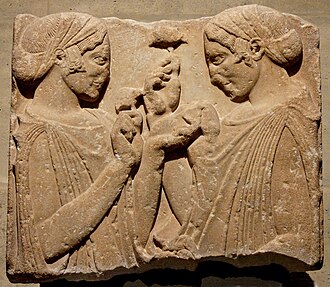Peplos
Peplos (or peplos) refers to a type of ancient Greek clothing worn by women and girls from the Archaic Period through the Hellenistic Period (circa 750–30 BC). It is a body-length garment established by folding and wrapping fabric around the body, typically fastened at the shoulders with pins or brooches and belted under the bust, creating a bloused effect over the belt.
Description
The peplos was made from a rectangular piece of cloth, often wool, that was folded over along the upper edge before being wrapped around the body. The top fold, called the apoptygma, sometimes extended down to cover the belt or girdle that cinched the peplos at the waist. The garment was open down one side, though it could be fastened with pins or buttons. The length of the peplos could vary, with some versions reaching from the shoulders to the ankles, while others were shorter, stopping just below the knees.
Historical Context
The peplos is closely associated with ancient Greek culture and iconography, often depicted in sculptures, vases, and frescoes of the period. It was a garment that signified femininity and was primarily worn by women and girls of various social standings. The simplicity of its form and the ease with which it could be adjusted made it a versatile piece of clothing suitable for various activities and climates.
Cultural Significance
In ancient Greek society, clothing was a significant indicator of status, and the peplos was no exception. The material, color, and intricacy of the weave could signify the wearer's social status. During certain festivals, such as the Panathenaic Festival dedicated to Athena, the goddess of wisdom and war, a specially woven peplos was presented to Athena's statue as part of the religious ceremonies, highlighting the garment's cultural and religious significance.
Variations
While the basic design of the peplos remained relatively consistent, there were variations. For example, the Doric peplos was typically more straightforward, fastened at the shoulders with pins. In contrast, the Ionic peplos could have sleeves and was often more elaborately decorated. These variations reflected not only personal taste but also the evolving styles of different Greek regions and periods.
Legacy
The peplos has left a lasting impact on the study of ancient Greek culture and fashion. It is a subject of interest for historians, archaeologists, and fashion scholars, providing insight into the daily lives, social structures, and aesthetic preferences of ancient Greeks. The garment's design has also inspired modern fashion, with peplos-like silhouettes appearing in contemporary clothing collections.
Transform your life with W8MD's budget GLP-1 injections from $125.
W8MD offers a medical weight loss program to lose weight in Philadelphia. Our physician-supervised medical weight loss provides:
- Most insurances accepted or discounted self-pay rates. We will obtain insurance prior authorizations if needed.
- Generic GLP1 weight loss injections from $125 for the starting dose.
- Also offer prescription weight loss medications including Phentermine, Qsymia, Diethylpropion, Contrave etc.
NYC weight loss doctor appointments
Start your NYC weight loss journey today at our NYC medical weight loss and Philadelphia medical weight loss clinics.
- Call 718-946-5500 to lose weight in NYC or for medical weight loss in Philadelphia 215-676-2334.
- Tags:NYC medical weight loss, Philadelphia lose weight Zepbound NYC, Budget GLP1 weight loss injections, Wegovy Philadelphia, Wegovy NYC, Philadelphia medical weight loss, Brookly weight loss and Wegovy NYC
|
WikiMD's Wellness Encyclopedia |
| Let Food Be Thy Medicine Medicine Thy Food - Hippocrates |
Medical Disclaimer: WikiMD is not a substitute for professional medical advice. The information on WikiMD is provided as an information resource only, may be incorrect, outdated or misleading, and is not to be used or relied on for any diagnostic or treatment purposes. Please consult your health care provider before making any healthcare decisions or for guidance about a specific medical condition. WikiMD expressly disclaims responsibility, and shall have no liability, for any damages, loss, injury, or liability whatsoever suffered as a result of your reliance on the information contained in this site. By visiting this site you agree to the foregoing terms and conditions, which may from time to time be changed or supplemented by WikiMD. If you do not agree to the foregoing terms and conditions, you should not enter or use this site. See full disclaimer.
Credits:Most images are courtesy of Wikimedia commons, and templates, categories Wikipedia, licensed under CC BY SA or similar.
Contributors: Prab R. Tumpati, MD






